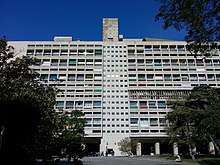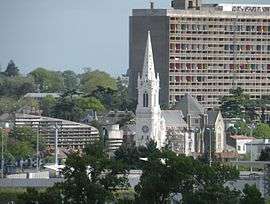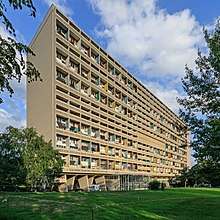Unité d'habitation
The Unité d'habitation (French pronunciation: [ynite dabitasjɔ̃], Housing Unit) is a modernist residential housing design principle developed by Le Corbusier, with the collaboration of painter-architect Nadir Afonso. The concept formed the basis of several housing developments designed by him throughout Europe with this name. The most famous of these developments is located in south Marseille.

.jpg)


History
Unité d'habitation buildings were designed by Swiss-French architect Le Corbusier. In 1920, Corbusier started to develop the type apartment which became very influential in 20th century modernism and contemporary residential design in Europe. The first full-scale models were built in Paris and Marseille during the planning of the first high rise concrete structure in the 1940s. During completion of the Marseille building a few model apartments were completed and furnished for visitors as an exhibition. In the 1980s a team from ETH Zurich surveyed several apartments in Marseille and a several full-scale models were constructed for exhibitions in Paris, Karlsruhe, Tokyo and New York. In 1986 a full-scale model was constructed at the Badischer Kunstverein by Gernot Bayne based on the survey of Ruggero Tropeano. The same model was then on display at Centre Pompidou. A full scale original Kitchen, stairs and other parts of the apartments are stored and displayed several museum collections around the world. The Cuisine Atelier Le Corbusier, type 1, designed by Charlotte Perriand in cooperation with the Atelier Le Corbusier. A total of 321 apartments of the Unité were furnished with this kitchen. The Museum of Modern Art acquired a complete kitchen in 2013.[1][2][3] In 2007 students built a structurally correct full-scale model inside the Museum Cité in Paris.[4][5][6] Unité d'habitation model apartments have been rebuilt in exhibitions or renovated in their historic style.[7]
Cité radieuse, Marseille
The first and most famous of these buildings, also known as Cité radieuse (Radiant City) and, informally, as La Maison du Fada (French – Provençal, "The Madman's House"), is located in Marseille, France, and was built between 1947 and 1952. One of Le Corbusier's most famous works, it proved enormously influential and is often cited as the initial inspiration of the Brutalist architectural style and philosophy.[8]
The building is constructed in béton brut (rough-cast concrete), as the hoped-for steel frame proved too expensive in light of post-War shortages.[8] In July 2016, the Unité in Marseille and several other works by Le Corbusier were inscribed as UNESCO World Heritage Sites.[9] It is also designated a historic monument by the French Ministry of Culture. It was damaged by fire on February 9, 2012.[10][11]
The Marseille building, developed with Corbusier's designers Shadrach Woods and George Candilis, comprises 337 apartments arranged over twelve stories, all suspended on large piloti. The building also incorporates shops with an architectural bookshop,[12] a rooftop gallery, educational facilities, a hotel which is open to the public,[13] and a gastronomic restaurant, Le Ventre de l'architecte ("The Belly of the Architect").
Inside, corridors run through the centre of the long axis of every third floor of the building, with each apartment lying on two levels, and stretching from one side of the building to the other, with a balcony. Corbusier's design was criticised by US architect Peter Blake for having small children's rooms and some of those rooms lacked windows.[14] Unlike many of the inferior system-built blocks it inspired, which lack the original's generous proportions, communal facilities and parkland setting, the Unité is popular with its residents and is now mainly occupied by upper middle-class professionals.
The flat roof is designed as a communal terrace with sculptural ventilation stacks, a running track, and a shallow paddling pool for children. There is also a children's art school in the atelier. The roof, where a number of theatrical performances have taken place, underwent renovation in 2010 and since 2013 it hosts an exhibition center called the MaMo.[15] The roof has unobstructed views of the Mediterranean and Marseille.
According to Peter Blake, members of CIAM held a "great celebration" for the building's opening on the roof on a summer evening in 1953. "Architects from every part of the world attended", including Walter Gropius, who said at the event: "Any architect who does not find this building beautiful, had better lay down his pencil."[16]
Other buildings and influences
In the block's planning, the architect drew on his study of the Soviet communal housing project, the Narkomfin Building in Moscow, which had been designed by the architect Moisei Ginzburg and completed in 1932.
Le Corbusier's utopian city living design was repeated in four more buildings with this name and a very similar design:
- Unité d'Habitation of Nantes-Rezé in 1955,
- Unité d'Habitation of Berlin in 1957,
- Unité d'Habitation of Briey in 1963,
- Unité d'Habitation of Firminy-Vert in 1965.
All of them were oriented with the building's long axis running north–south, so the units face east-and-west.[17]
The replacement material (béton brut) influenced the Brutalist movement, and the building inspired several housing complexes including the Alton West estate in Roehampton, London, and Park Hill in Sheffield. These buildings have attracted a great deal of criticism. Other, more successful, manifestations of the Unité include Chamberlin, Powell and Bon's Barbican Estate (completed 1982), Gordon Tait's Samuda Estate, Isle of Dogs (1965), Ernő Goldfinger's Balfron Tower (1967), and Trellick Tower (1972), all in London. Other valuable complexes strongly inspired with the idea were Za Żelazną Bramą Housing Estate (Behind the Iron Gate) in Warsaw, and Superjednostka in Katowice, built in seventies.
A unique example among Central European countries is the apartment building called PAN (Polska Akademia Nauk) inspired by Le Corbusier's principles, abstract sculptural building floating over pilotis, including big apartments, without tiny flats and with roof terrace and swimming pool in Wiejska Street 20, in Warsaw, Poland, dated 1964 by architect Jerzy Gieysztor. Building was inspired also by World Expo 1937 in Paris, especially in the part of relief walls and entrance roof[18].
The Reserve Square Complex in Cleveland, Ohio which was built 1969–1973 was also influenced by Le Corbusier's project.
The Riverside Plaza in Minneapolis, Minnesota, which opened in 1973, also used multi-colored panels and brutalist design, as influenced by the project.
A building (1954) in Vukovarska street in Zagreb by architect Drago Galić was inspired by Le Corbusier's principles.
Interiors
The apartments were equipped with built-in furniture, and specially designed storage walls with various cupboards with sliding doors, which were designed by Charlotte Perriand in collaboration with Atelier Le Corbusier. Additionally Perriand collaborated on the design of the apartment kitchens, 321 of the 337 units were equipped with the Cuisine Atelier Le Corbusier, type 1 kitchens, many of which are still in place due to their efficient use of space.[19] The steel stairs and the aluminium kitchen counters were designed by Jean Prouvé. Unité d'habitation model apartments have been renovated in the individual historic Unité buildings as well as rebuilt in exhibitions around the world.
See also
- Plattenbau
- Tower block
- University Apartments (Chicago, Illinois)
References
- "MoMA buys flat-pack kitchen - Architecture - Agenda - Phaidon". Phaidon.
- Bechthold, Tim; Reischl, Julia (1 August 2012). "Kitchen stories:Cuisine Atelier Le Corbusier, type 1". Studies in Conservation. 57 (sup1): S27–S35. doi:10.1179/2047058412y.0000000028.
- "Meuble Cuisine Atelier Le Corbusier Type 1 - Centre Pompidou".
- "Cité de l'architecture et du patrimoine". Cité de l'architecture & du patrimoine.
- "Model museum on a grand scale in Paris".
- "Paris's Architecture Museum: La Cité de l'Architecture et du Patrimoine - stephanekirkland.com". stephanekirkland.com.
- https://www.amazon.fr/cellule-Corbusier-LUnité-dhabitation-Marseille/dp/2919230050
- Banham, Reyner (1966). The New Brutalism: Ethic or Aesthetic?. New York: Reinhold Publishing Company. p. 16.
- "The Architectural Work of Le Corbusier". UNESCO World Heritage Centre. United Nations Educational, Scientific and Cultural Organization. Retrieved 19 July 2016.
- "Grave incendie à la Cité radieuse du Corbusier à Marseille". Le Monde.fr. 9 February 2012 – via Le Monde.
- "Archived copy". Archived from the original on 2012-12-30. Retrieved 2012-02-10.CS1 maint: archived copy as title (link)
- bleuroy.com. "Librairie le corbusier - livres d architecture - livres urbanisme - Editions imbernon". www.editionsimbernon.com.
- Love, Hotels We. "Sleep Marseille - Hotels We Love". Hotels We Love.
- "What's Wrong with Modern Architecture? Plenty, Says Critic Peter Blake". People. 12 Sep 1977. Retrieved 7 February 2016.
- "Marseille : le MaMo, un centre d'art entre ciel et mer". 2013-05-06.
- Blake, Peter (1964). Le Corbusier: Architecture and Form. Pelican book. Penguin Books. p. 124.
- "Le Corbusier and the Sun". solarhousehistory.com.
- Marta Leśniakowska Architektura w Warszawie: lata 1945-1965 Warszawa 2003
- Bechthold, Tim (2012). "Kitchen stories: Cuisine Atelier Le Corbusier, type 1". Studies in Conservation. 57: S27–S35. doi:10.1179/2047058412y.0000000028 – via Taylor & Francis Online.
External links
| Wikimedia Commons has media related to Unité d'habitation. |
- Essay on the Unité d'Habitation in the Financial Times
- Official website
- Glancey, Jonathan (2013-05-02), "Le Corbusier's Unité: Is it a modern classic?", BBC Culture